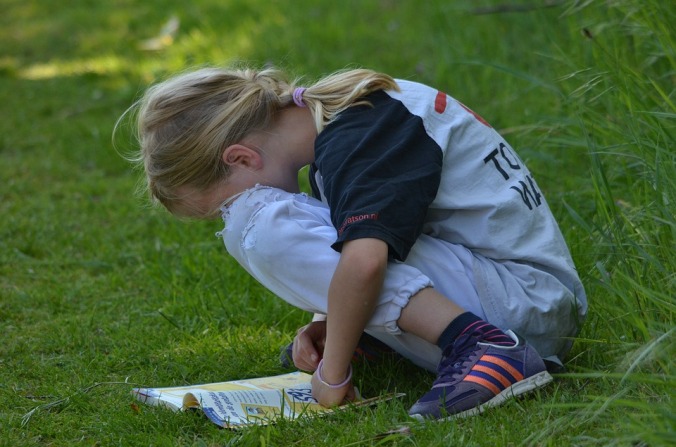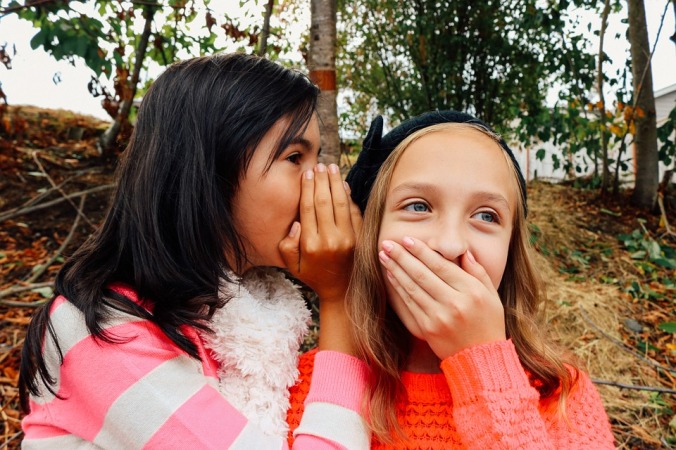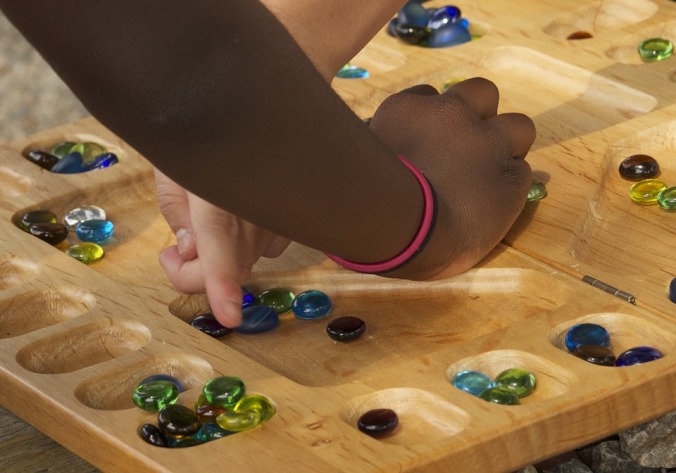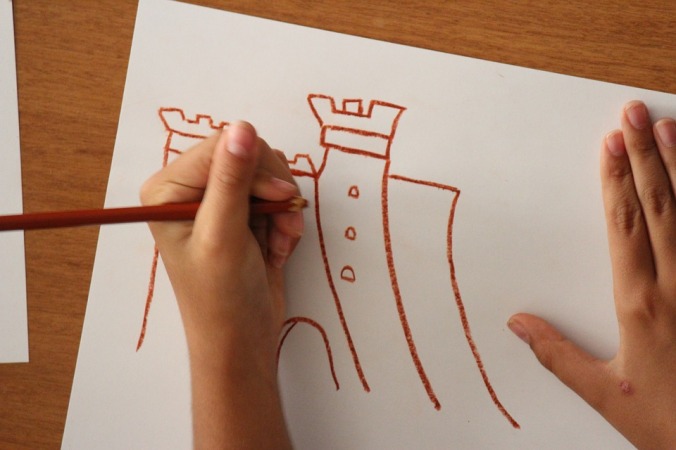
To learn to read is to light a fire; every syllable that is spelled out is a spark. – Victor Hugo
Reading readiness and reading advancement has little or nothing to do with educational toys, apps, or enrichment programs. It has much more to do with what kids naturally like to do: move their bodies, enjoy stories, take part in conversation, and play freely.
Why?
Movement helps children develop sufficient brain-body maturation so they can successful decode abstract symbols into meaning. This includes complex neurological pathways as well as sufficient kinesthetic awareness and proprioceptive sense. (Find out what movements are essential in “Reading Readiness Has To Do With the Body.”)
Reading aloud every day, starting in babyhood, helps children associate reading with closeness and pleasure. Even a board book builds vocabulary, demonstrates left to right sequencing, and promotes comprehension. We can fold reading time into daily rituals like story time before naps and again after dinner. We can also show how much we value reading by letting kids see us reading our own books and magazines.
As kids get older it’s important to avoid offering rewards for reading or make reading a precondition for privileges. That’s because rewards, even for something kids already enjoy, significantly diminishes their own intrinsic motivation. Telling kids “20 minutes of reading before you can play games on the tablet”casts reading as an obligation, leading kids to devalue reading while enhancing the appeal of digital entertainment. (No wonder “eat your broccoli before you can have ice cream” makes broccoli the enemy and ice cream even more tempting.)
Stories stretch the mind and imagination. They help us, at any age, develop empathy and give us a larger context for our own lives. That’s not limited to the page. There’s extraordinary power in telling family stories. When we share tales of our doubts, misdeeds, and triumphs we’re not only building family cohesiveness, we’re also (according to science) helping kids grow up with greater confidence and self-control.
Daily conversations, including all those questions kids ask, helps them advance in reasoning and social skills while bringing us closer to each other. Let’s admit, a great deal of parent and child interaction isn’t true conversation so much as directives, complaints, and reminders (because, well, life) so it helps to create openings for conversation. Hold a space for kids to talk about what’s on their minds —- this often seems to happen on a walk, a drive, or at bedtime —- good times to avoid earbuds and screens. Make a practice of showing you’re listening by using eye contact and avoiding interruption. Talk about big issues and dilemmas in your lives, in your community, and in the news. Big topics have a way of stretching young minds.
Free play is an essential part of childhood. It also helps kids develop the skills necessary for reading well. It may look like fun, but in ways deeper and more vital than we can imagine play is a process of learning. We don’t have to engineer their play. Play is, and always has been, a universal language. Give kids as much time for free play as possible. But when you want to play along, here are a few ideas.
Word Play

- Tell simple jokes (sorry, this includes Knock Knock jokes), attempt tongue twisters, call each other made-up names, say goodbye in rhymes like “Out of the door dinosaur!” and “See you later excavator!“
- Play Cherries & Pits to get conversations started. Very simply, each person takes turns telling the best things (Cherries) about their day and the worst things (Pits) about their day.
- Tell round robin stories. One person starts a story with a character and setting (“The elf woke up to find a large bird staring at him.”). The next person adds a few sentences before passing it along to the next person. This works well with as little as two people and nearly always becomes amusingly improbable.
- Turn socks into puppets for impromptu plays. Puppeteers can hide behind a couch or sheet-covered table to perform, although socks in my house tend to talk on their way to the laundry.
- Make story stones (pictures on stones or tiles) and grab a few to prompt a story idea. Other stones can be added as the story goes on.
- Ask off-the-wall questions. “Would you rather be a monkey or a lion?” “What would it be like if people had wings?” “If we could go on an adventure together what would we do?”
- Write messages to each other. Scratch a few words in the sand, leave a message in magnetic letters, designate a place (under each other’s bed pillows, perhaps) where secret notes can be left, share a question and answer journal (taking turns asking and answering any and all questions), and leave little love letters for kids to find.
- Sing songs with familiar tunes and invented lyrics. Those tend to be somewhat scatological in my family, a favorite faux opera here has to do with encouraging dogs to go out and get their elimination duties over with….
Games

- Play impromptu memory games. For example, take turns tapping out a beat, seeing if the next person can repeat it. Or try imitating movements in sequence (first person jumps, the other person jumps and adds clapping, first person jumps and claps and adds a turkey gobble, and so on). Or take turns memorizing a sequence of unrelated words to repeat back in two minutes or ten minutes or the next day. Be prepared to lose to your kids!
- Play hand-motion games like Wheels on the Bus, Itsy Bitsy Spider, and Cee Cee My Playmate. Show kids jump rope rhymes. (You might check out Anna Banana: 101 Jump Rope Rhymes by Joanna Cole.) And don’t forget hopscotch rhymes. Research shows these simple games help kids become better spellers, have neater handwriting, and better overall writing skills.
- Encourage classic games like checkers, mancala, and chess. Games of all kinds typically help kids understand sequencing, grouping, and memory. No need to choose specifically educational games.
- Make your own board games along with your child.
- Set aside one evening a week as a family board game night or set up a kids’ game club with friends. (There are even great games for kids three and under like Roll & Play, First Orchard, and Feed the Woozle.)
- Waiting in line with kids? Find objects that begin with each letter of the alphabet together, from avocados to zeros. Or play the classic Going on a Picnic game. Start by saying, “I’m going on a picnic and I’m bringing an aardvark (or any “A” word). The next person continues with “I’m going on a picnic and I’m bringing an aardvark and a basketball (or any word starting with a B) and so on. The last person to remember and repeat the list is the winner.
- Encourage active games. Consult Great Games! 175 Games & Activities for Families, Groups, & Children! by Matthew Toone and Mom´s Handy Book of Backyard Games by Pete Cava.
- Use the dictionary (print copy!) to play surprisingly addictive word games like Blackbird.
Map Play

- Encourage kids to draw maps of places they know well (your kitchen, your house, your street) and maps of imaginary places (alien planets, mythic kingdoms, ninja training camps). Draw a map of where you’ve hidden packed lunches for them to discover or the bedtime chapter book you’ll read.
- Encourage children to set up obstacle courses. Indoors this may include three somersaults through the hall, chairs to wriggle under, a rope to hop over, and a bunk bed ladder to climb. Outdoors the course can be more ambitious.
- Enjoy regular treasure hunts. First hide a prize or two. Then place clues through the house or yard. These can be simple words or sentences, symbols, or pictures. Each clue leads to the next. The prize doesn’t have to be a toy or candy (it could be a note saying “we’re going to the park!”) the fun is in the hunting. Encourage children to set up their up treasure hunts too.
- Letterboxing combines walking, navigation, and solving riddles. Clues help seekers find “letterboxes” hidden outdoors. Seekers mark their logbooks with a rubber stamp found in this box, mark a logbook in the box with their own personal stamp, then leave the box for the next seeker. For more information and links to regional clues, check with organizations such as Letterboxing North America or Atlas Quest. Or use the guidebook, It’s a Treasure Hunt! Geocaching & Letterboxing.
- Try orienteering. This sport combines navigation, map reading, and decision-making. Participants walk, run, bike, or ski using a map and compass to choose the best route on or off the trail. Consult Orienteering Made Simple And Gps Technology: An Instructional Handbook by Nancy Kelly.
- Take turns playing Line Zombie. Draw a line on paper with a pencil or on the ground with chalk, using arrows to indicate direction. The other person must follow the line either by tracing on the paper with marker or walking on the chalk line. Zombie noises optional.
Portions of this post adapted from Free Range Learning.
On behalf of all those who believe in children and play and know the delight of reading, thank you for this, Laura the Good Grace
LikeLiked by 1 person
Thanks for pointing out the connection between movement and play and reading. It makes so much sense!
LikeLiked by 1 person
I loved this article – thank you for putting this together. As both mother and teacher there are so many fabulous reminders and insights in here. Many thanks.
LikeLiked by 1 person
Just what I need to share with parents of children I care for. There is so much pressure these days for children to be the first and best at ‘reading’ ‘writing’ etc that sometimes the importance of encouraging a love for reading and underpinning the learning is forgotten
LikeLike